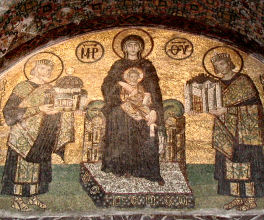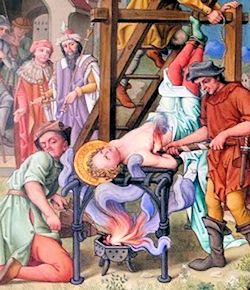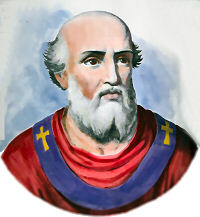Easter: May 18th
Optional Memorial of St. John I, pope and martyr
» Enjoy our Liturgical Seasons series of e-books!
Old Calendar: St. Venantius, martyr
John I was elected Pope in 523. The Arian King Theodoric sent him as his ambassador to Emperor Justin in Constantinople. On John I's return, he was captured by the king, who was displeased at the outcome of the embassy, and cast him into prison at Ravenna where he died a few days later. As pope he was responsible for introducing the Alexandrian computation of the date of Easter; it came to be accepted throughout the West.
According to the 1962 Missal of St. John XXIII the Extraordinary Form of the Roman Rite, today is the feast of St. Venantius, who was born at Camerino in Umbria, and was led at the age of fifteen before Antiochus, governor of the town under the Emperor Decius. He was made to suffer cruel torments, but angels came and assisted him. His tormentors were touched with repentance by his constancy and many were converted. He was beheaded around the year 250. His body lies at Camerino in the church dedicated to him. St. John I's feast in the Ordinary Form of the Roman Rite is celebrated on May 27.
St. John I
This Tuscan was destined to be glorified not only during his lifetime but after his death as well. Although peace with the East had been restored, a suspicious Theodoric grumbled in his castle at Ravenna. An Arian, the king saw the new friendliness between East and West as a serious threat to his reign. To further alarm him, Emperor Justin had reinstated the laws against heretics, Arians included, and had embarked on a campaign of confiscating churches and excluding heretics from public office, causing many Arians to abandon their faith. Infuriated, Theodoric summoned John to Ravenna and ordered him to head a delegation to the orthodox emperor to ask that the persecution stop and allow forced converts to return to Arianism. At first John refused, then fearing that the king's wrath would be taken out on Western Catholics, he agreed to do Theodoric's bidding on every count save one. He boldly told the king that he would not ask the emperor to allow converts to return to heresy.
The pope arrived in Constantinople shortly before Easter in 526, and since he was the first pope to leave Italy, his reception was more than he could have dreamed. He had been met by the entire city at the twelfth milestone, where the clergy led the procession carrying candles and crosses, and even the emperor prostrated himself before the Holy Father.  The day of Easter, John was seated in a throne higher than the one occupied by the patriarch, in the church of Sancta Sophia, where he celebrated Mass in the Latin tradition. John was accorded the highest honor when he placed the customary Easter crown on the head of Emperor Justin.
The day of Easter, John was seated in a throne higher than the one occupied by the patriarch, in the church of Sancta Sophia, where he celebrated Mass in the Latin tradition. John was accorded the highest honor when he placed the customary Easter crown on the head of Emperor Justin.
After meeting with Justin on Theodoric's behalf, the pope made the exhausting trip back to Ravenna. The king's fury raged. Jealous of the pope's grand reception in the East, Theodoric accused the pope of failing his mission by not securing all of the demands put to Justin. The king then ordered John to remain in Ravenna at his disposal. The aged pope was spent; the prospects before him were dismal. Already ailing, Pope John died and was hastily buried outside the castle walls. Pope John's body was exhumed and on May 27, 526, was returned to Rome and placed in the nave of St. Peter's.
— Excerpted from The Popes: A Papal History, J.V. Bartlett
Things to Do:
- The Church has had a long, unbroken line of popes. Have your children answer the following questions: How many popes has the Church had? How many popes are honored with the title of saint, blessed or venerable? Which pope reigned longest? Which three names have been chosen most frequently by popes? You can check this page to help get the answers.
- Pray especially for the Holy Father today. Make sure your children know the Morning Offering in which we pray for the Holy Father's intentions.
- Read more about Pope St. John I at Catholic News Agency.
St. Venantius St. Venantius was born at Camerino in Italy, and at the age of fifteen was seized as a Christian and carried before a judge. As it was found impossible to shake his constancy either by threats or promises, he was condemned to be scourged, but was miraculously saved by an angel. He was then burnt with torches and hung over a low fire that he might be suffocated by the smoke. The judge's secretary, admiring the steadfastness of the Saint, and seeing an angel robed in white, who trampled out the fire and again set free the youthful martyr, proclaimed his faith in Christ, was baptized with his whole family, and shortly after won the martyr's crown himself.
St. Venantius was born at Camerino in Italy, and at the age of fifteen was seized as a Christian and carried before a judge. As it was found impossible to shake his constancy either by threats or promises, he was condemned to be scourged, but was miraculously saved by an angel. He was then burnt with torches and hung over a low fire that he might be suffocated by the smoke. The judge's secretary, admiring the steadfastness of the Saint, and seeing an angel robed in white, who trampled out the fire and again set free the youthful martyr, proclaimed his faith in Christ, was baptized with his whole family, and shortly after won the martyr's crown himself.
Venantius was then carried before the governor, who, unable to make him renounce his faith, cast him into prison with an apostate, who vainly strove to tempt him. The governor then ordered his teeth and jaws to be broken, and had him thrown into a furnace, from which the angel once more delivered him. The Saint was again led before the judge, who at sight of him fell headlong from his seat and expired, crying, "The God of Venantius is the true God; let us destroy our idols." This circumstance being told to the governor, he ordered Venantius to be thrown to the lions; but these brutes, forgetting their natural ferocity, crouched at the feet of the Saint. Then, by order of the tyrant, the young martyr was dragged through a heap of brambles and thorns, but again God manifested the glory of His servant; the soldiers suffering from thirst, the Saint knelt on a rock and signed it with a cross, when immediately a jet of clear, cool water spurted up from the spot.
This miracle converted many of those who beheld it, whereupon the governor had Venantius and his converts beheaded together in the year 250. The bodies of these martyrs are kept in the church at Camerino which bears the Saint's name.
Excerpted from Lives of the Saints, by Alban Butler, Benziger Bros. ed. [1894]
Patron: Camerino, Italy.
Symbols: Roman armour; banner; plan of Camerino; fountain.
Often portrayed as: Young man crucified upside-down with smoke coming from his head; young man holding the citadel of Camerino; young man holding the city of Camerino, a palm, and a book; young man with a banner holding a city wall.
Things to do:
- Today, let us renew our commitment to reading Scripture and take some time to meditate on a passage of the Gospel.
